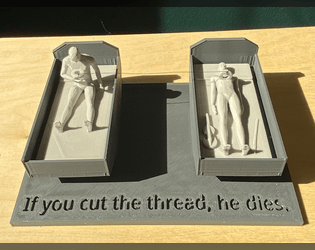Yes—I love that I can bring them out every semester!
It can be a bit tedious and irritating to restring the cut models, depending on what you use to tie them… I was using embroidery floss, which is finicky, and I will probably switch to a nice chunky yarn for next semester.
It is great that they can see what other students have chosen, agreed—but even better is that they are FORCED to choose themselves. When I teach thought experiments without the models, there are always a few students who don’t seem to pay very close attention, perhaps just because they have trouble imagining the case. And there are others, too, who tend to waffle around rather than get serious about what they would actually do, but the models really focus everyone on the scenario. And whether or not they’ve been interacted with (string cut or scissors set deliberately aside) let’s me know when the whole class is ready for the next part of the lesson, in which they all now have a stake.
(Next semester, I will ask students who decide not to cut actually bring their scissors back up to the front so I have a clear indicator both ways when they are finished.)


